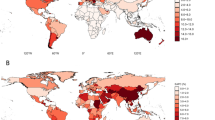Abstract
The Psychiatric Intensive Care Unit at the FDR VA Hospital is a specialized ward designed to assess and treat suicidal and assaultive patients. Since its creation in 1983, over 1600 admissions have taken place. The authors have previously reported that patients referred for aggressive behavior had a statistically significant higher recidivism rate, as well as a statistically significant longer length of stay. The unit went through several changes in response to externally perceived needs and available resources. When the census cap was decreased, the referral pattern changed and the patients were even more likely to be aggressive. Length of stay decreased dramatically leading to a unit with a significantly higher turnover rate. Clinical and administrative concerns are also discussed.
Similar content being viewed by others
References
Musisi SM, Wasylenki DA, Rapp MS: A psychiatric intensive care unit in a psychiatric hospital. Canadian Journal of Psychiatry 34(3):200–204, 1989.
Rachlin S: On the need for a closed ward in an open hospital: the psychiatric intensive care unit. Hospital and Community Psychiatry 24:829–833, 1972.
Basson JV, Woodside M: Assessment of a secure/intensive care/forensic ward. Acta Psychiatr Scand 64:132–141, 1981.
Goldney R, Bowes J, Spence N, Czechowicz A, Hurley R: The psychiatric intensive care unit. British Journal of Psychiatry 146:50–54, 1985.
Wameke L: A psychiatric intensive care unit in a general hospital setting. Canadian Journal of Psychiatry 31(9):834–837, 1986.
Birnie WA, Matsuno K: The psychiatric acute observation unit in a general hospital. Canadian Journal of Psychiatry 33(8):707–710, 1988.
Crain PM, Jordan EG: The psychiatric intensive care unit: an in-hospital treatment of violent adult patients. Academy of Psychiatry and the Law Bulletin 7:190–198, 1979.
Allan ER, Brown RC, Laury G: Planning a psychiatric intensive care unit. Hospital and Community Psychiatry 39(1):81–82, 1988.
Khan A, Cohen S, Chiles J, Stowell M, Hyde T, Robbins M: Therapeutic role of a psychiatric intensive care unit in acute psychosis. Comprehensive Psychiatry 28(3):264–269, 1987.
Citrome L, Green L, Fost R: Length of stay and recidivism in a psychiatric intensive care unit. Hospital and Community Psychiatry, 45(1):74–76, 1994.
Alpert M, Allan ER, Citrome L, et al.: A double-blind, placebo-controlled study of adjunctive nadolol in the management of violent psychiatric patients. Psychopharmacology Bulletin 26(3):367–371, 1990.
Citrome L, Green L: The dangerous agitated patient. Postgraduate Medicine 87(2):231–236, 1990.
Author information
Authors and Affiliations
Additional information
Work done at the FDR VA Hospital, Montrose, N.Y.
Rights and permissions
About this article
Cite this article
Citrome, L., Green, L. & Forst, R. Clinical and administrative consequences of a reduced census on a Psychiatric Intensive Care Unit. Psych Quart 66, 209–217 (1995). https://doi.org/10.1007/BF02265671
Issue Date:
DOI: https://doi.org/10.1007/BF02265671




